Economics for Business EFB: UK Price Elasticity and Taxation Analysis
VerifiedAdded on 2023/06/09
|10
|3033
|119
Report
AI Summary
This report examines the impact of price elasticity of demand and supply on UK consumers and suppliers, respectively. It analyzes the challenges faced by UK households due to price elasticity, income elasticity, and cross-price elasticity of demand. The report further discusses the benefits and costs of consumer taxation in the UK, relating to elasticities, consumer surplus, and deadweight loss. It also analyzes a UK taxation example between 2020 and 2022, evaluating its positive and negative impacts on the UK economy with supporting evidence. The analysis covers various elasticity categories, including perfectly elastic, relatively elastic, unit elastic, perfectly inelastic, and relatively inelastic scenarios, providing a comprehensive overview of the subject matter. Desklib offers a wealth of similar resources for students.
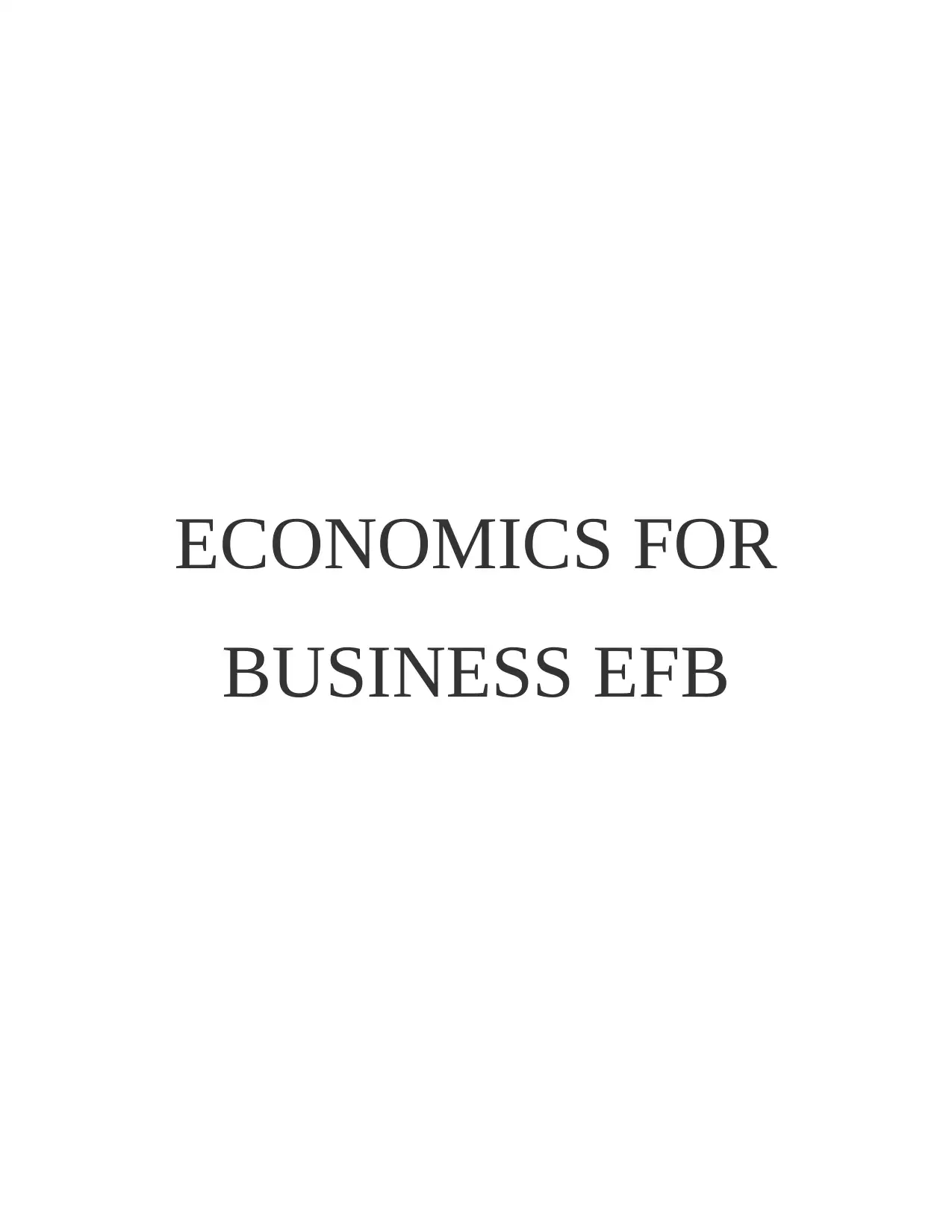
ECONOMICS FOR
BUSINESS EFB
BUSINESS EFB
Paraphrase This Document
Need a fresh take? Get an instant paraphrase of this document with our AI Paraphraser
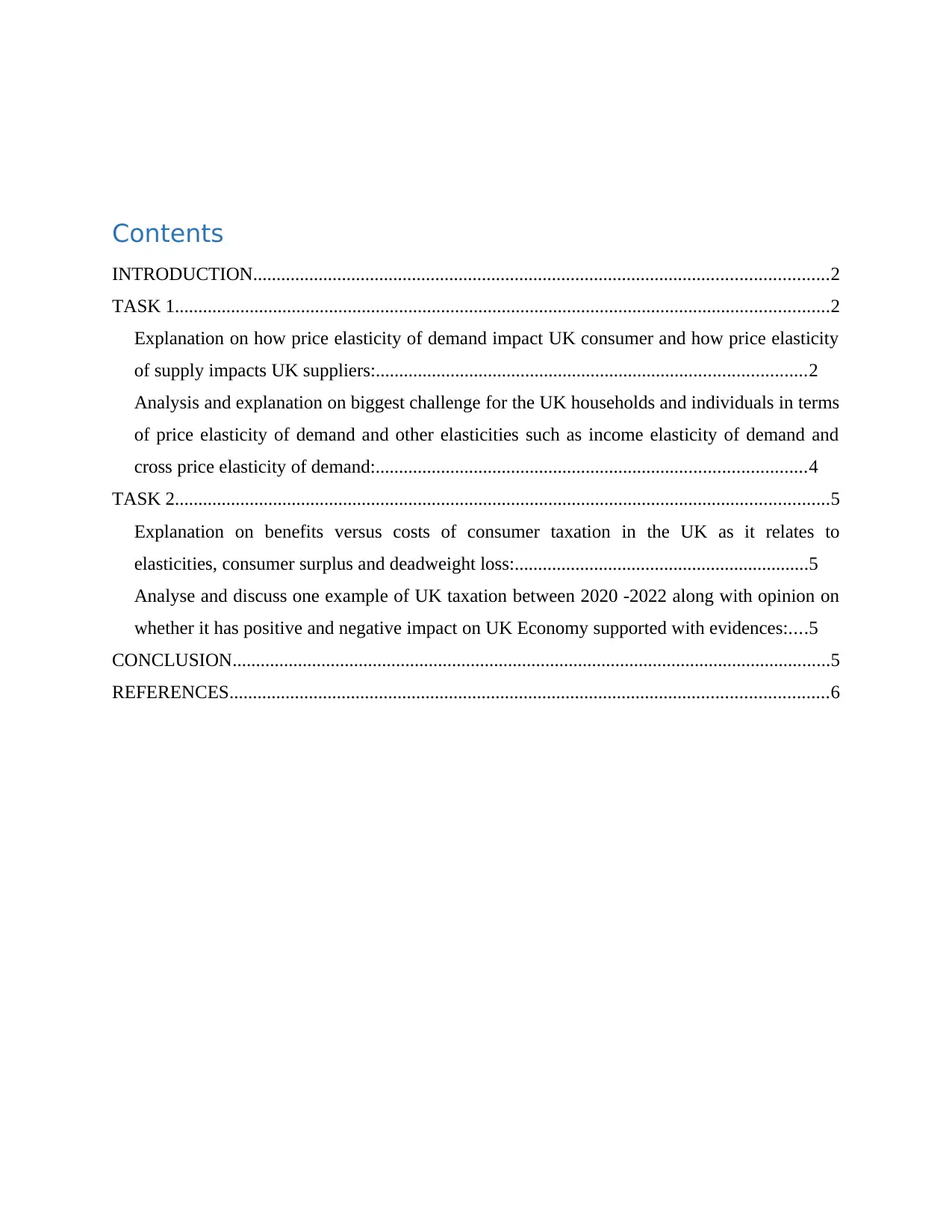
Contents
INTRODUCTION...........................................................................................................................2
TASK 1............................................................................................................................................2
Explanation on how price elasticity of demand impact UK consumer and how price elasticity
of supply impacts UK suppliers:............................................................................................2
Analysis and explanation on biggest challenge for the UK households and individuals in terms
of price elasticity of demand and other elasticities such as income elasticity of demand and
cross price elasticity of demand:............................................................................................4
TASK 2............................................................................................................................................5
Explanation on benefits versus costs of consumer taxation in the UK as it relates to
elasticities, consumer surplus and deadweight loss:...............................................................5
Analyse and discuss one example of UK taxation between 2020 -2022 along with opinion on
whether it has positive and negative impact on UK Economy supported with evidences:....5
CONCLUSION................................................................................................................................5
REFERENCES................................................................................................................................6
INTRODUCTION...........................................................................................................................2
TASK 1............................................................................................................................................2
Explanation on how price elasticity of demand impact UK consumer and how price elasticity
of supply impacts UK suppliers:............................................................................................2
Analysis and explanation on biggest challenge for the UK households and individuals in terms
of price elasticity of demand and other elasticities such as income elasticity of demand and
cross price elasticity of demand:............................................................................................4
TASK 2............................................................................................................................................5
Explanation on benefits versus costs of consumer taxation in the UK as it relates to
elasticities, consumer surplus and deadweight loss:...............................................................5
Analyse and discuss one example of UK taxation between 2020 -2022 along with opinion on
whether it has positive and negative impact on UK Economy supported with evidences:....5
CONCLUSION................................................................................................................................5
REFERENCES................................................................................................................................6
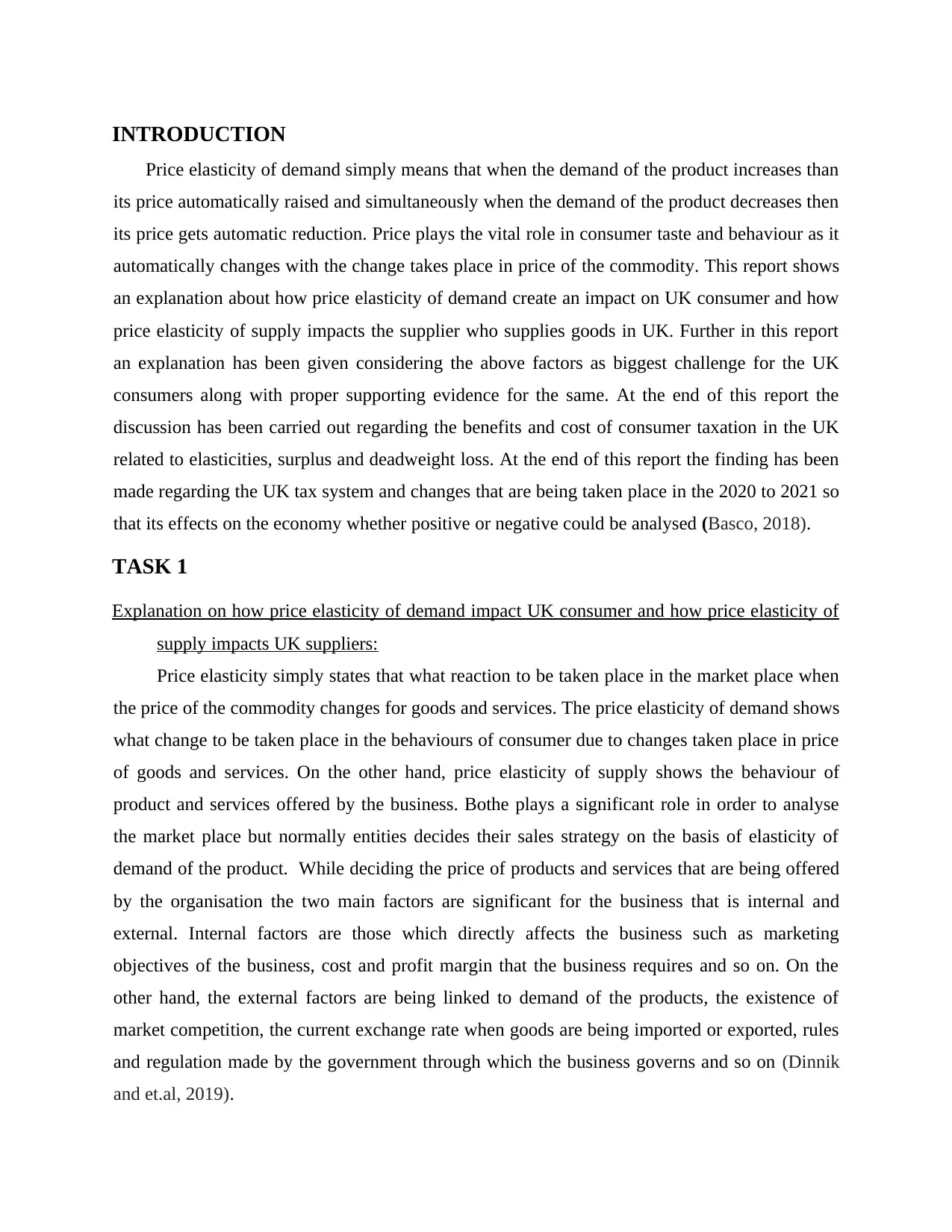
INTRODUCTION
Price elasticity of demand simply means that when the demand of the product increases than
its price automatically raised and simultaneously when the demand of the product decreases then
its price gets automatic reduction. Price plays the vital role in consumer taste and behaviour as it
automatically changes with the change takes place in price of the commodity. This report shows
an explanation about how price elasticity of demand create an impact on UK consumer and how
price elasticity of supply impacts the supplier who supplies goods in UK. Further in this report
an explanation has been given considering the above factors as biggest challenge for the UK
consumers along with proper supporting evidence for the same. At the end of this report the
discussion has been carried out regarding the benefits and cost of consumer taxation in the UK
related to elasticities, surplus and deadweight loss. At the end of this report the finding has been
made regarding the UK tax system and changes that are being taken place in the 2020 to 2021 so
that its effects on the economy whether positive or negative could be analysed (Basco, 2018).
TASK 1
Explanation on how price elasticity of demand impact UK consumer and how price elasticity of
supply impacts UK suppliers:
Price elasticity simply states that what reaction to be taken place in the market place when
the price of the commodity changes for goods and services. The price elasticity of demand shows
what change to be taken place in the behaviours of consumer due to changes taken place in price
of goods and services. On the other hand, price elasticity of supply shows the behaviour of
product and services offered by the business. Bothe plays a significant role in order to analyse
the market place but normally entities decides their sales strategy on the basis of elasticity of
demand of the product. While deciding the price of products and services that are being offered
by the organisation the two main factors are significant for the business that is internal and
external. Internal factors are those which directly affects the business such as marketing
objectives of the business, cost and profit margin that the business requires and so on. On the
other hand, the external factors are being linked to demand of the products, the existence of
market competition, the current exchange rate when goods are being imported or exported, rules
and regulation made by the government through which the business governs and so on (Dinnik
and et.al, 2019).
Price elasticity of demand simply means that when the demand of the product increases than
its price automatically raised and simultaneously when the demand of the product decreases then
its price gets automatic reduction. Price plays the vital role in consumer taste and behaviour as it
automatically changes with the change takes place in price of the commodity. This report shows
an explanation about how price elasticity of demand create an impact on UK consumer and how
price elasticity of supply impacts the supplier who supplies goods in UK. Further in this report
an explanation has been given considering the above factors as biggest challenge for the UK
consumers along with proper supporting evidence for the same. At the end of this report the
discussion has been carried out regarding the benefits and cost of consumer taxation in the UK
related to elasticities, surplus and deadweight loss. At the end of this report the finding has been
made regarding the UK tax system and changes that are being taken place in the 2020 to 2021 so
that its effects on the economy whether positive or negative could be analysed (Basco, 2018).
TASK 1
Explanation on how price elasticity of demand impact UK consumer and how price elasticity of
supply impacts UK suppliers:
Price elasticity simply states that what reaction to be taken place in the market place when
the price of the commodity changes for goods and services. The price elasticity of demand shows
what change to be taken place in the behaviours of consumer due to changes taken place in price
of goods and services. On the other hand, price elasticity of supply shows the behaviour of
product and services offered by the business. Bothe plays a significant role in order to analyse
the market place but normally entities decides their sales strategy on the basis of elasticity of
demand of the product. While deciding the price of products and services that are being offered
by the organisation the two main factors are significant for the business that is internal and
external. Internal factors are those which directly affects the business such as marketing
objectives of the business, cost and profit margin that the business requires and so on. On the
other hand, the external factors are being linked to demand of the products, the existence of
market competition, the current exchange rate when goods are being imported or exported, rules
and regulation made by the government through which the business governs and so on (Dinnik
and et.al, 2019).
⊘ This is a preview!⊘
Do you want full access?
Subscribe today to unlock all pages.

Trusted by 1+ million students worldwide
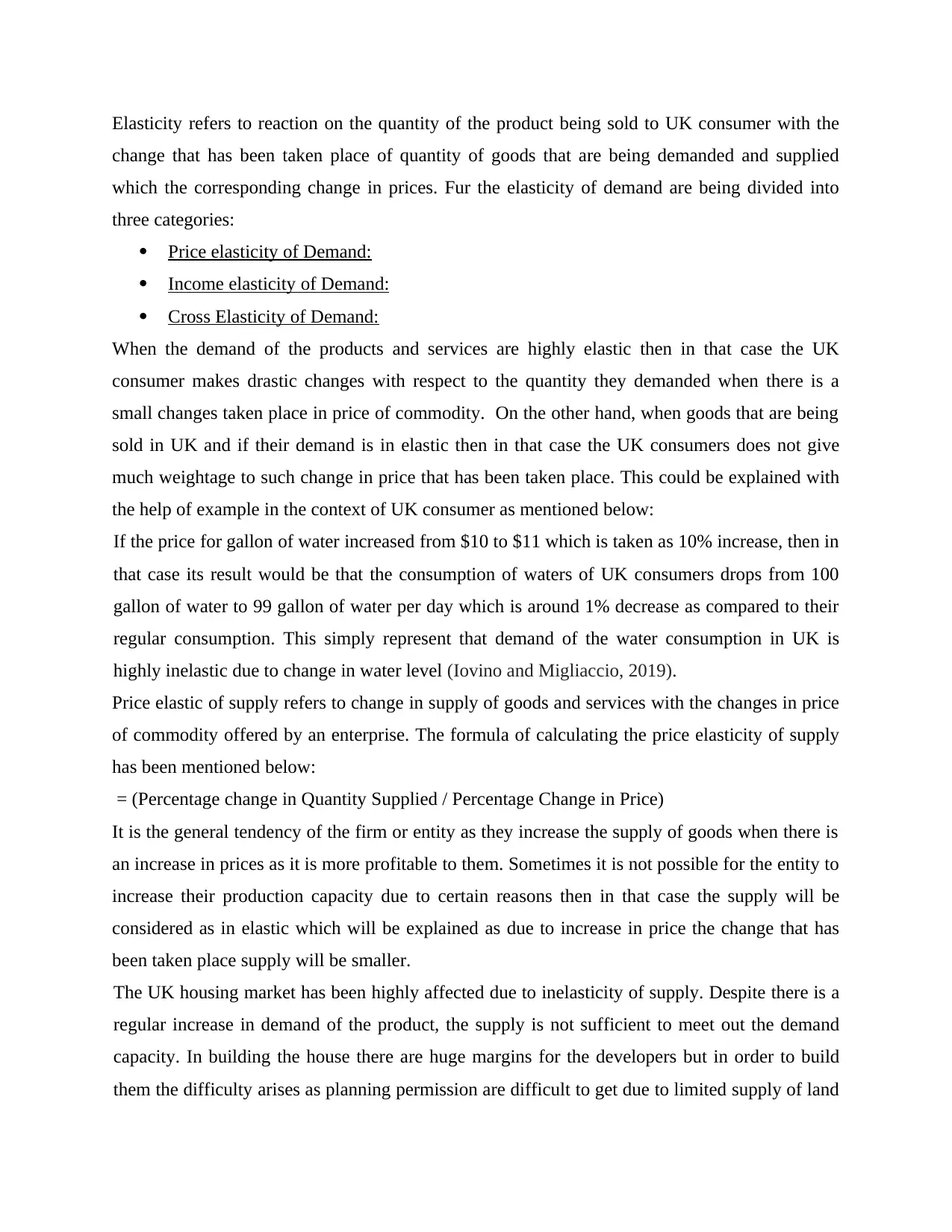
Elasticity refers to reaction on the quantity of the product being sold to UK consumer with the
change that has been taken place of quantity of goods that are being demanded and supplied
which the corresponding change in prices. Fur the elasticity of demand are being divided into
three categories:
Price elasticity of Demand:
Income elasticity of Demand:
Cross Elasticity of Demand:
When the demand of the products and services are highly elastic then in that case the UK
consumer makes drastic changes with respect to the quantity they demanded when there is a
small changes taken place in price of commodity. On the other hand, when goods that are being
sold in UK and if their demand is in elastic then in that case the UK consumers does not give
much weightage to such change in price that has been taken place. This could be explained with
the help of example in the context of UK consumer as mentioned below:
If the price for gallon of water increased from $10 to $11 which is taken as 10% increase, then in
that case its result would be that the consumption of waters of UK consumers drops from 100
gallon of water to 99 gallon of water per day which is around 1% decrease as compared to their
regular consumption. This simply represent that demand of the water consumption in UK is
highly inelastic due to change in water level (Iovino and Migliaccio, 2019).
Price elastic of supply refers to change in supply of goods and services with the changes in price
of commodity offered by an enterprise. The formula of calculating the price elasticity of supply
has been mentioned below:
= (Percentage change in Quantity Supplied / Percentage Change in Price)
It is the general tendency of the firm or entity as they increase the supply of goods when there is
an increase in prices as it is more profitable to them. Sometimes it is not possible for the entity to
increase their production capacity due to certain reasons then in that case the supply will be
considered as in elastic which will be explained as due to increase in price the change that has
been taken place supply will be smaller.
The UK housing market has been highly affected due to inelasticity of supply. Despite there is a
regular increase in demand of the product, the supply is not sufficient to meet out the demand
capacity. In building the house there are huge margins for the developers but in order to build
them the difficulty arises as planning permission are difficult to get due to limited supply of land
change that has been taken place of quantity of goods that are being demanded and supplied
which the corresponding change in prices. Fur the elasticity of demand are being divided into
three categories:
Price elasticity of Demand:
Income elasticity of Demand:
Cross Elasticity of Demand:
When the demand of the products and services are highly elastic then in that case the UK
consumer makes drastic changes with respect to the quantity they demanded when there is a
small changes taken place in price of commodity. On the other hand, when goods that are being
sold in UK and if their demand is in elastic then in that case the UK consumers does not give
much weightage to such change in price that has been taken place. This could be explained with
the help of example in the context of UK consumer as mentioned below:
If the price for gallon of water increased from $10 to $11 which is taken as 10% increase, then in
that case its result would be that the consumption of waters of UK consumers drops from 100
gallon of water to 99 gallon of water per day which is around 1% decrease as compared to their
regular consumption. This simply represent that demand of the water consumption in UK is
highly inelastic due to change in water level (Iovino and Migliaccio, 2019).
Price elastic of supply refers to change in supply of goods and services with the changes in price
of commodity offered by an enterprise. The formula of calculating the price elasticity of supply
has been mentioned below:
= (Percentage change in Quantity Supplied / Percentage Change in Price)
It is the general tendency of the firm or entity as they increase the supply of goods when there is
an increase in prices as it is more profitable to them. Sometimes it is not possible for the entity to
increase their production capacity due to certain reasons then in that case the supply will be
considered as in elastic which will be explained as due to increase in price the change that has
been taken place supply will be smaller.
The UK housing market has been highly affected due to inelasticity of supply. Despite there is a
regular increase in demand of the product, the supply is not sufficient to meet out the demand
capacity. In building the house there are huge margins for the developers but in order to build
them the difficulty arises as planning permission are difficult to get due to limited supply of land
Paraphrase This Document
Need a fresh take? Get an instant paraphrase of this document with our AI Paraphraser
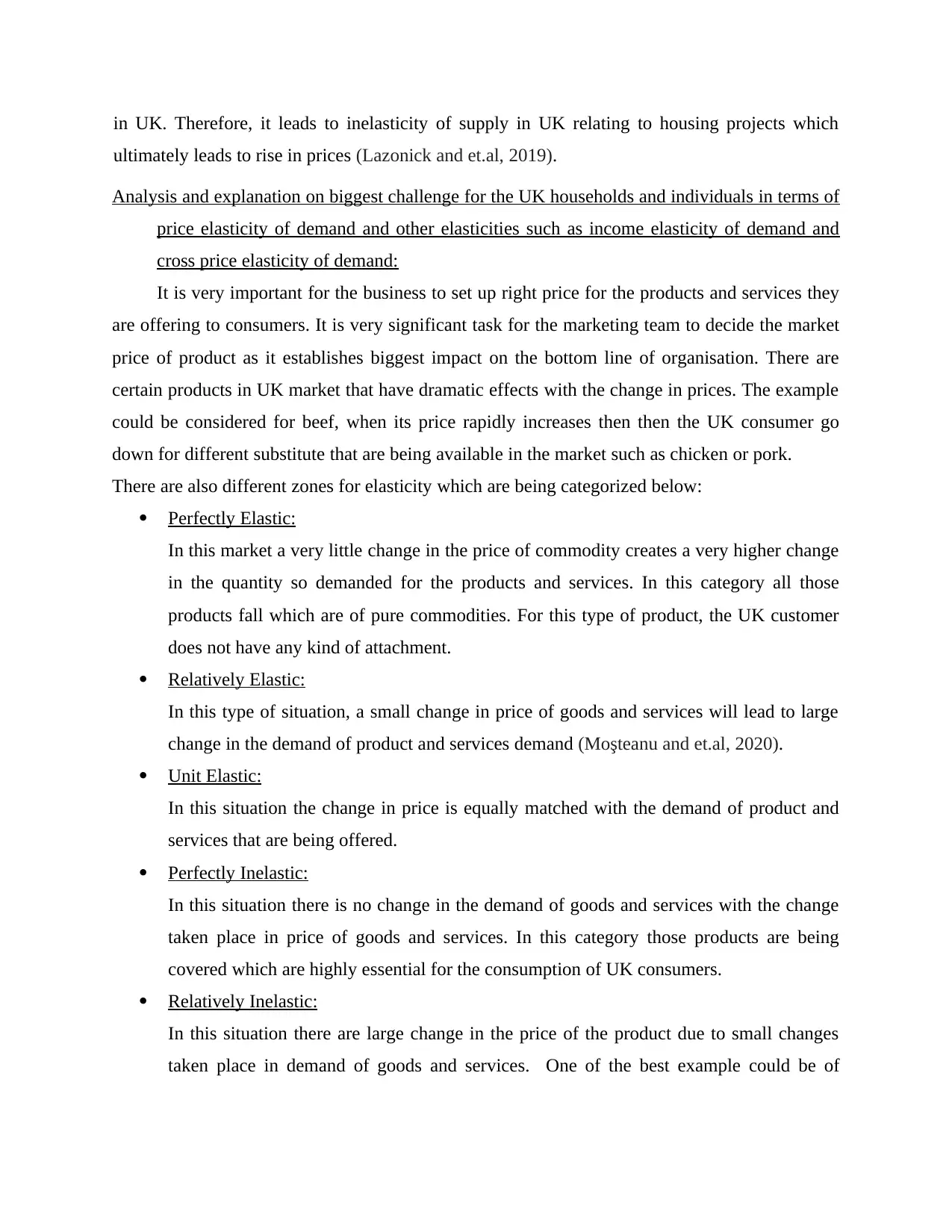
in UK. Therefore, it leads to inelasticity of supply in UK relating to housing projects which
ultimately leads to rise in prices (Lazonick and et.al, 2019).
Analysis and explanation on biggest challenge for the UK households and individuals in terms of
price elasticity of demand and other elasticities such as income elasticity of demand and
cross price elasticity of demand:
It is very important for the business to set up right price for the products and services they
are offering to consumers. It is very significant task for the marketing team to decide the market
price of product as it establishes biggest impact on the bottom line of organisation. There are
certain products in UK market that have dramatic effects with the change in prices. The example
could be considered for beef, when its price rapidly increases then then the UK consumer go
down for different substitute that are being available in the market such as chicken or pork.
There are also different zones for elasticity which are being categorized below:
Perfectly Elastic:
In this market a very little change in the price of commodity creates a very higher change
in the quantity so demanded for the products and services. In this category all those
products fall which are of pure commodities. For this type of product, the UK customer
does not have any kind of attachment.
Relatively Elastic:
In this type of situation, a small change in price of goods and services will lead to large
change in the demand of product and services demand (Moşteanu and et.al, 2020).
Unit Elastic:
In this situation the change in price is equally matched with the demand of product and
services that are being offered.
Perfectly Inelastic:
In this situation there is no change in the demand of goods and services with the change
taken place in price of goods and services. In this category those products are being
covered which are highly essential for the consumption of UK consumers.
Relatively Inelastic:
In this situation there are large change in the price of the product due to small changes
taken place in demand of goods and services. One of the best example could be of
ultimately leads to rise in prices (Lazonick and et.al, 2019).
Analysis and explanation on biggest challenge for the UK households and individuals in terms of
price elasticity of demand and other elasticities such as income elasticity of demand and
cross price elasticity of demand:
It is very important for the business to set up right price for the products and services they
are offering to consumers. It is very significant task for the marketing team to decide the market
price of product as it establishes biggest impact on the bottom line of organisation. There are
certain products in UK market that have dramatic effects with the change in prices. The example
could be considered for beef, when its price rapidly increases then then the UK consumer go
down for different substitute that are being available in the market such as chicken or pork.
There are also different zones for elasticity which are being categorized below:
Perfectly Elastic:
In this market a very little change in the price of commodity creates a very higher change
in the quantity so demanded for the products and services. In this category all those
products fall which are of pure commodities. For this type of product, the UK customer
does not have any kind of attachment.
Relatively Elastic:
In this type of situation, a small change in price of goods and services will lead to large
change in the demand of product and services demand (Moşteanu and et.al, 2020).
Unit Elastic:
In this situation the change in price is equally matched with the demand of product and
services that are being offered.
Perfectly Inelastic:
In this situation there is no change in the demand of goods and services with the change
taken place in price of goods and services. In this category those products are being
covered which are highly essential for the consumption of UK consumers.
Relatively Inelastic:
In this situation there are large change in the price of the product due to small changes
taken place in demand of goods and services. One of the best example could be of
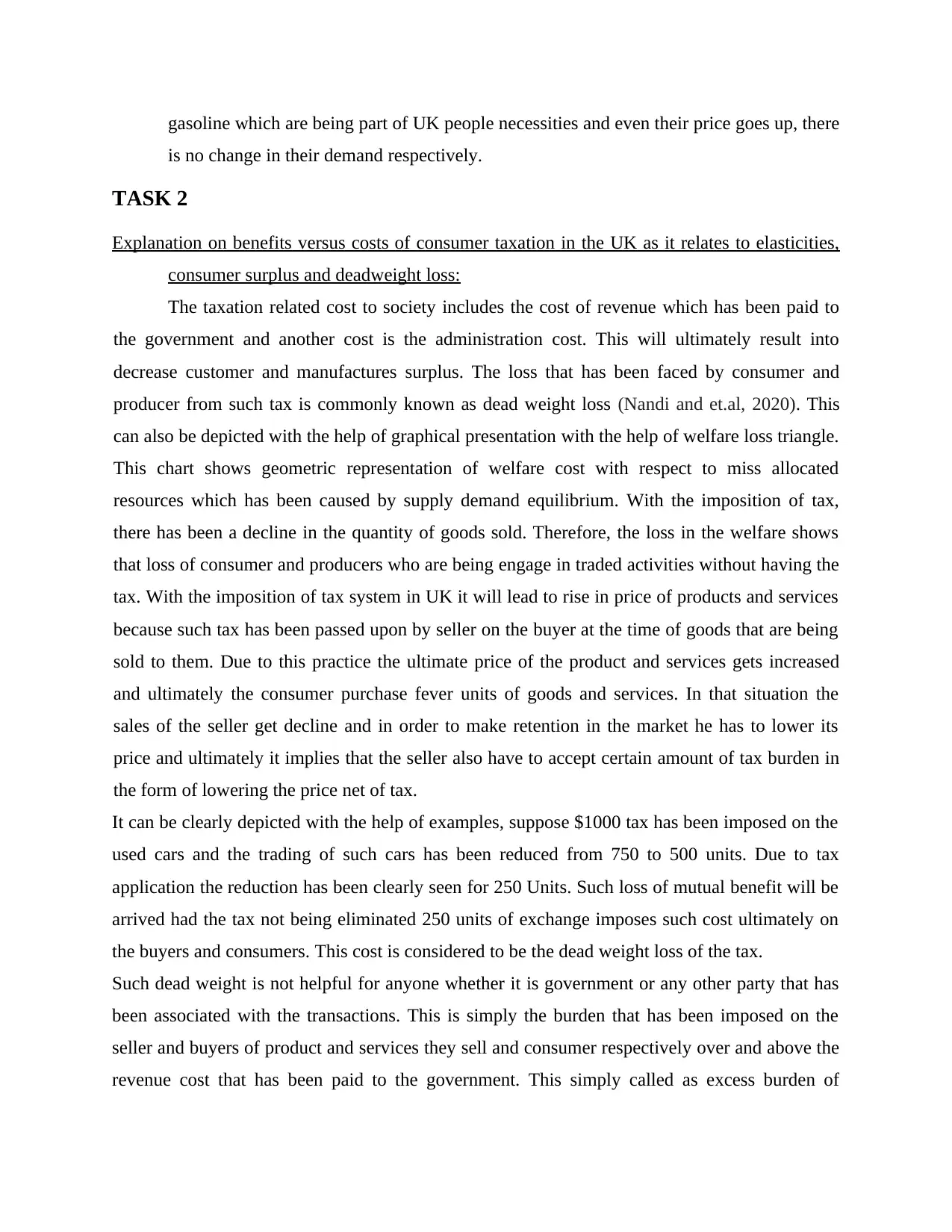
gasoline which are being part of UK people necessities and even their price goes up, there
is no change in their demand respectively.
TASK 2
Explanation on benefits versus costs of consumer taxation in the UK as it relates to elasticities,
consumer surplus and deadweight loss:
The taxation related cost to society includes the cost of revenue which has been paid to
the government and another cost is the administration cost. This will ultimately result into
decrease customer and manufactures surplus. The loss that has been faced by consumer and
producer from such tax is commonly known as dead weight loss (Nandi and et.al, 2020). This
can also be depicted with the help of graphical presentation with the help of welfare loss triangle.
This chart shows geometric representation of welfare cost with respect to miss allocated
resources which has been caused by supply demand equilibrium. With the imposition of tax,
there has been a decline in the quantity of goods sold. Therefore, the loss in the welfare shows
that loss of consumer and producers who are being engage in traded activities without having the
tax. With the imposition of tax system in UK it will lead to rise in price of products and services
because such tax has been passed upon by seller on the buyer at the time of goods that are being
sold to them. Due to this practice the ultimate price of the product and services gets increased
and ultimately the consumer purchase fever units of goods and services. In that situation the
sales of the seller get decline and in order to make retention in the market he has to lower its
price and ultimately it implies that the seller also have to accept certain amount of tax burden in
the form of lowering the price net of tax.
It can be clearly depicted with the help of examples, suppose $1000 tax has been imposed on the
used cars and the trading of such cars has been reduced from 750 to 500 units. Due to tax
application the reduction has been clearly seen for 250 Units. Such loss of mutual benefit will be
arrived had the tax not being eliminated 250 units of exchange imposes such cost ultimately on
the buyers and consumers. This cost is considered to be the dead weight loss of the tax.
Such dead weight is not helpful for anyone whether it is government or any other party that has
been associated with the transactions. This is simply the burden that has been imposed on the
seller and buyers of product and services they sell and consumer respectively over and above the
revenue cost that has been paid to the government. This simply called as excess burden of
is no change in their demand respectively.
TASK 2
Explanation on benefits versus costs of consumer taxation in the UK as it relates to elasticities,
consumer surplus and deadweight loss:
The taxation related cost to society includes the cost of revenue which has been paid to
the government and another cost is the administration cost. This will ultimately result into
decrease customer and manufactures surplus. The loss that has been faced by consumer and
producer from such tax is commonly known as dead weight loss (Nandi and et.al, 2020). This
can also be depicted with the help of graphical presentation with the help of welfare loss triangle.
This chart shows geometric representation of welfare cost with respect to miss allocated
resources which has been caused by supply demand equilibrium. With the imposition of tax,
there has been a decline in the quantity of goods sold. Therefore, the loss in the welfare shows
that loss of consumer and producers who are being engage in traded activities without having the
tax. With the imposition of tax system in UK it will lead to rise in price of products and services
because such tax has been passed upon by seller on the buyer at the time of goods that are being
sold to them. Due to this practice the ultimate price of the product and services gets increased
and ultimately the consumer purchase fever units of goods and services. In that situation the
sales of the seller get decline and in order to make retention in the market he has to lower its
price and ultimately it implies that the seller also have to accept certain amount of tax burden in
the form of lowering the price net of tax.
It can be clearly depicted with the help of examples, suppose $1000 tax has been imposed on the
used cars and the trading of such cars has been reduced from 750 to 500 units. Due to tax
application the reduction has been clearly seen for 250 Units. Such loss of mutual benefit will be
arrived had the tax not being eliminated 250 units of exchange imposes such cost ultimately on
the buyers and consumers. This cost is considered to be the dead weight loss of the tax.
Such dead weight is not helpful for anyone whether it is government or any other party that has
been associated with the transactions. This is simply the burden that has been imposed on the
seller and buyers of product and services they sell and consumer respectively over and above the
revenue cost that has been paid to the government. This simply called as excess burden of
⊘ This is a preview!⊘
Do you want full access?
Subscribe today to unlock all pages.

Trusted by 1+ million students worldwide
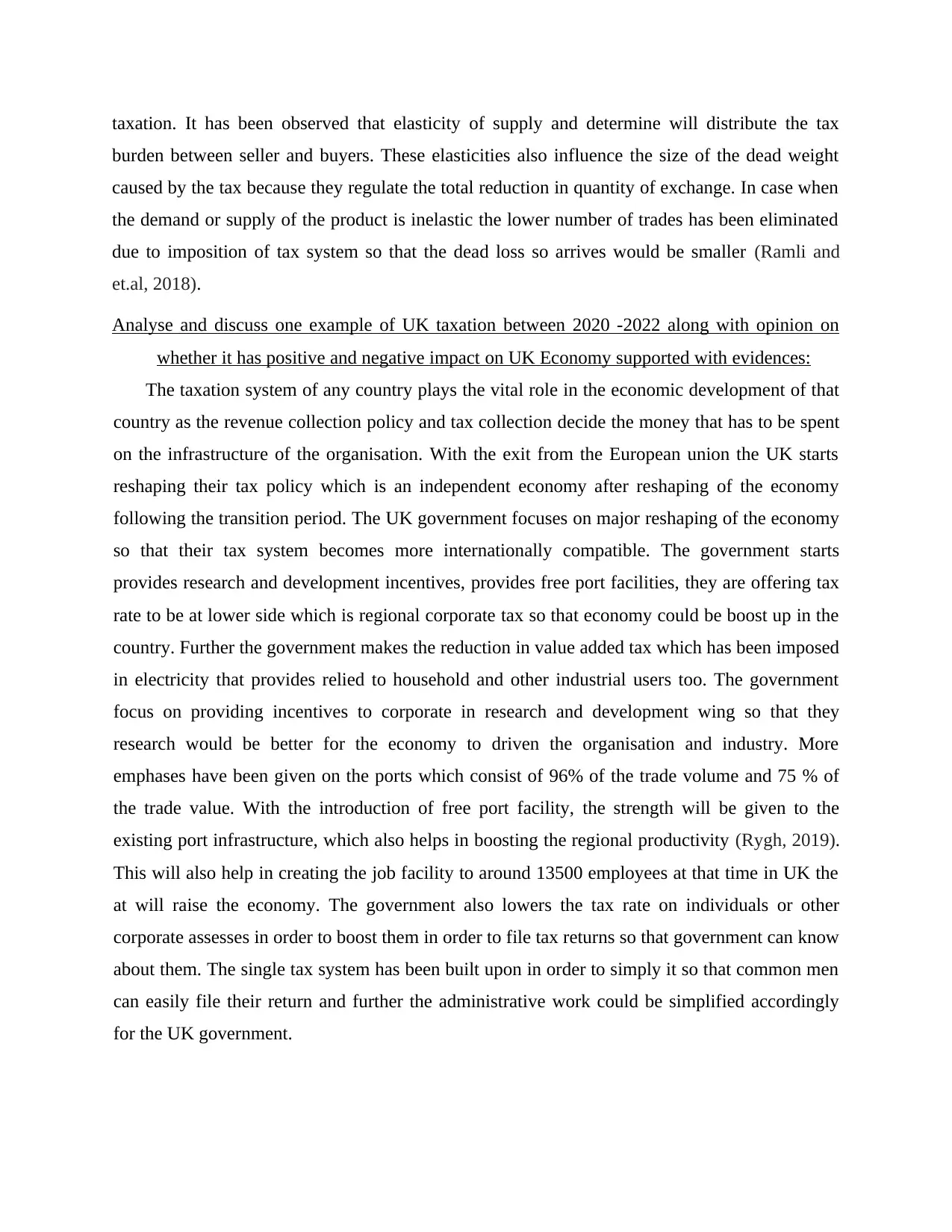
taxation. It has been observed that elasticity of supply and determine will distribute the tax
burden between seller and buyers. These elasticities also influence the size of the dead weight
caused by the tax because they regulate the total reduction in quantity of exchange. In case when
the demand or supply of the product is inelastic the lower number of trades has been eliminated
due to imposition of tax system so that the dead loss so arrives would be smaller (Ramli and
et.al, 2018).
Analyse and discuss one example of UK taxation between 2020 -2022 along with opinion on
whether it has positive and negative impact on UK Economy supported with evidences:
The taxation system of any country plays the vital role in the economic development of that
country as the revenue collection policy and tax collection decide the money that has to be spent
on the infrastructure of the organisation. With the exit from the European union the UK starts
reshaping their tax policy which is an independent economy after reshaping of the economy
following the transition period. The UK government focuses on major reshaping of the economy
so that their tax system becomes more internationally compatible. The government starts
provides research and development incentives, provides free port facilities, they are offering tax
rate to be at lower side which is regional corporate tax so that economy could be boost up in the
country. Further the government makes the reduction in value added tax which has been imposed
in electricity that provides relied to household and other industrial users too. The government
focus on providing incentives to corporate in research and development wing so that they
research would be better for the economy to driven the organisation and industry. More
emphases have been given on the ports which consist of 96% of the trade volume and 75 % of
the trade value. With the introduction of free port facility, the strength will be given to the
existing port infrastructure, which also helps in boosting the regional productivity (Rygh, 2019).
This will also help in creating the job facility to around 13500 employees at that time in UK the
at will raise the economy. The government also lowers the tax rate on individuals or other
corporate assesses in order to boost them in order to file tax returns so that government can know
about them. The single tax system has been built upon in order to simply it so that common men
can easily file their return and further the administrative work could be simplified accordingly
for the UK government.
burden between seller and buyers. These elasticities also influence the size of the dead weight
caused by the tax because they regulate the total reduction in quantity of exchange. In case when
the demand or supply of the product is inelastic the lower number of trades has been eliminated
due to imposition of tax system so that the dead loss so arrives would be smaller (Ramli and
et.al, 2018).
Analyse and discuss one example of UK taxation between 2020 -2022 along with opinion on
whether it has positive and negative impact on UK Economy supported with evidences:
The taxation system of any country plays the vital role in the economic development of that
country as the revenue collection policy and tax collection decide the money that has to be spent
on the infrastructure of the organisation. With the exit from the European union the UK starts
reshaping their tax policy which is an independent economy after reshaping of the economy
following the transition period. The UK government focuses on major reshaping of the economy
so that their tax system becomes more internationally compatible. The government starts
provides research and development incentives, provides free port facilities, they are offering tax
rate to be at lower side which is regional corporate tax so that economy could be boost up in the
country. Further the government makes the reduction in value added tax which has been imposed
in electricity that provides relied to household and other industrial users too. The government
focus on providing incentives to corporate in research and development wing so that they
research would be better for the economy to driven the organisation and industry. More
emphases have been given on the ports which consist of 96% of the trade volume and 75 % of
the trade value. With the introduction of free port facility, the strength will be given to the
existing port infrastructure, which also helps in boosting the regional productivity (Rygh, 2019).
This will also help in creating the job facility to around 13500 employees at that time in UK the
at will raise the economy. The government also lowers the tax rate on individuals or other
corporate assesses in order to boost them in order to file tax returns so that government can know
about them. The single tax system has been built upon in order to simply it so that common men
can easily file their return and further the administrative work could be simplified accordingly
for the UK government.
Paraphrase This Document
Need a fresh take? Get an instant paraphrase of this document with our AI Paraphraser
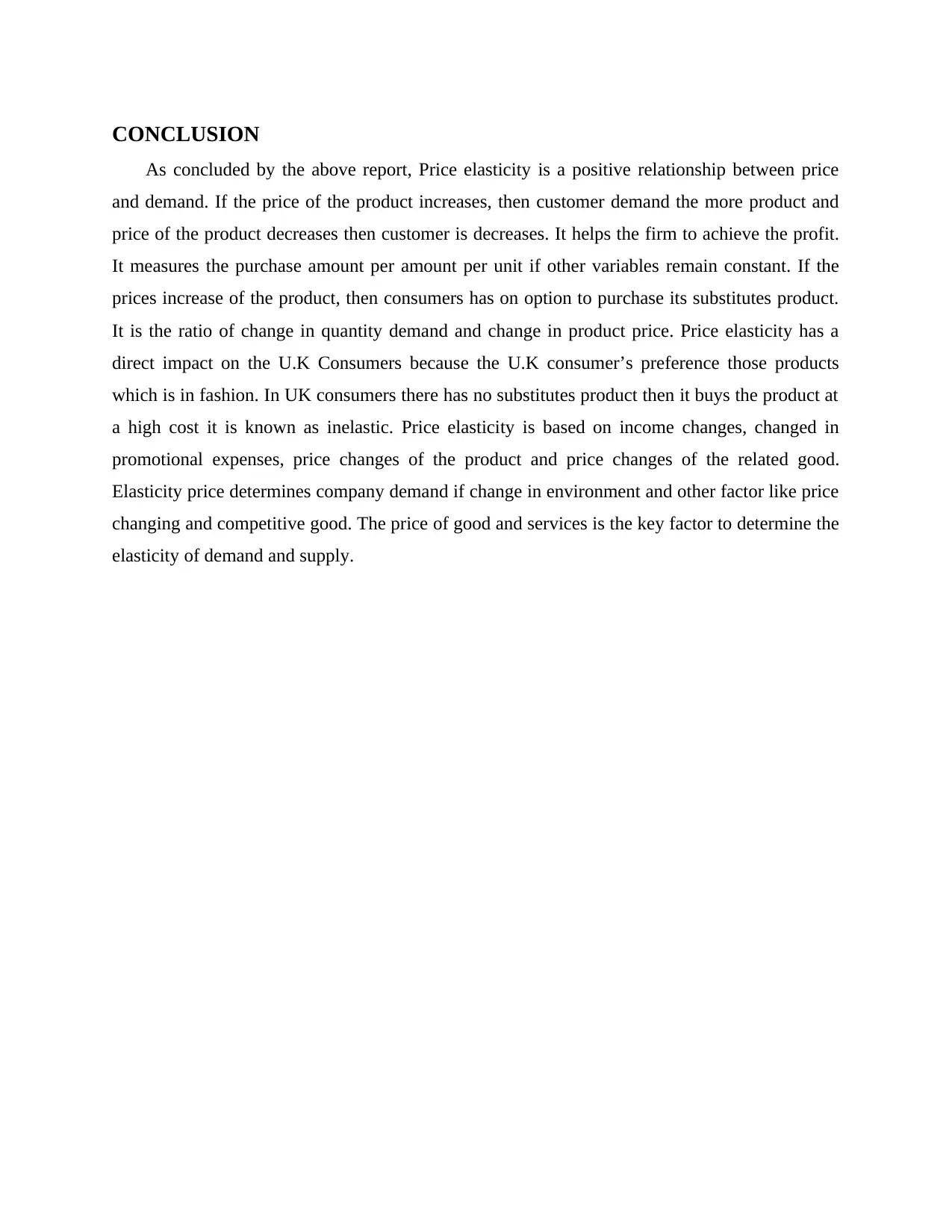
CONCLUSION
As concluded by the above report, Price elasticity is a positive relationship between price
and demand. If the price of the product increases, then customer demand the more product and
price of the product decreases then customer is decreases. It helps the firm to achieve the profit.
It measures the purchase amount per amount per unit if other variables remain constant. If the
prices increase of the product, then consumers has on option to purchase its substitutes product.
It is the ratio of change in quantity demand and change in product price. Price elasticity has a
direct impact on the U.K Consumers because the U.K consumer’s preference those products
which is in fashion. In UK consumers there has no substitutes product then it buys the product at
a high cost it is known as inelastic. Price elasticity is based on income changes, changed in
promotional expenses, price changes of the product and price changes of the related good.
Elasticity price determines company demand if change in environment and other factor like price
changing and competitive good. The price of good and services is the key factor to determine the
elasticity of demand and supply.
As concluded by the above report, Price elasticity is a positive relationship between price
and demand. If the price of the product increases, then customer demand the more product and
price of the product decreases then customer is decreases. It helps the firm to achieve the profit.
It measures the purchase amount per amount per unit if other variables remain constant. If the
prices increase of the product, then consumers has on option to purchase its substitutes product.
It is the ratio of change in quantity demand and change in product price. Price elasticity has a
direct impact on the U.K Consumers because the U.K consumer’s preference those products
which is in fashion. In UK consumers there has no substitutes product then it buys the product at
a high cost it is known as inelastic. Price elasticity is based on income changes, changed in
promotional expenses, price changes of the product and price changes of the related good.
Elasticity price determines company demand if change in environment and other factor like price
changing and competitive good. The price of good and services is the key factor to determine the
elasticity of demand and supply.
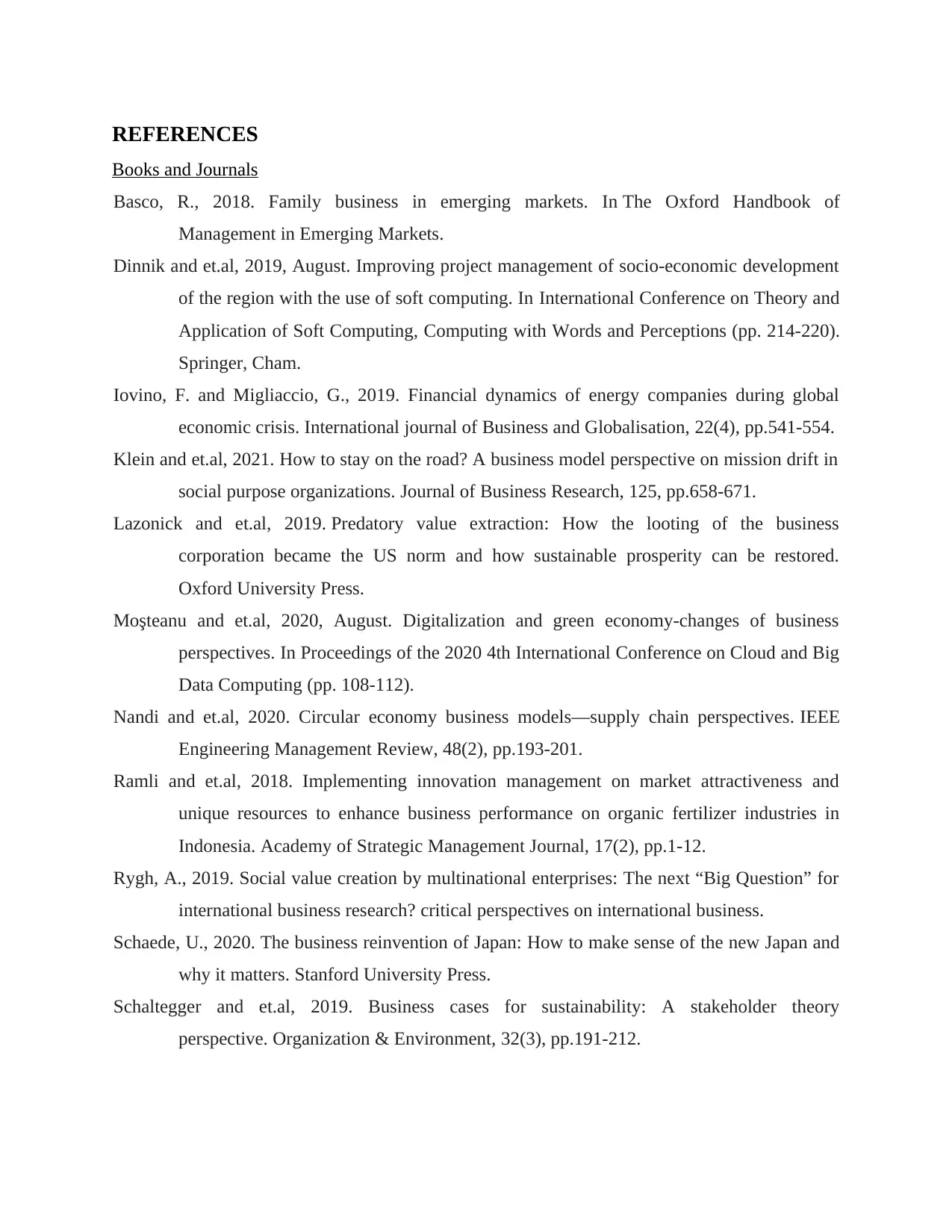
REFERENCES
Books and Journals
Basco, R., 2018. Family business in emerging markets. In The Oxford Handbook of
Management in Emerging Markets.
Dinnik and et.al, 2019, August. Improving project management of socio-economic development
of the region with the use of soft computing. In International Conference on Theory and
Application of Soft Computing, Computing with Words and Perceptions (pp. 214-220).
Springer, Cham.
Iovino, F. and Migliaccio, G., 2019. Financial dynamics of energy companies during global
economic crisis. International journal of Business and Globalisation, 22(4), pp.541-554.
Klein and et.al, 2021. How to stay on the road? A business model perspective on mission drift in
social purpose organizations. Journal of Business Research, 125, pp.658-671.
Lazonick and et.al, 2019. Predatory value extraction: How the looting of the business
corporation became the US norm and how sustainable prosperity can be restored.
Oxford University Press.
Moşteanu and et.al, 2020, August. Digitalization and green economy-changes of business
perspectives. In Proceedings of the 2020 4th International Conference on Cloud and Big
Data Computing (pp. 108-112).
Nandi and et.al, 2020. Circular economy business models—supply chain perspectives. IEEE
Engineering Management Review, 48(2), pp.193-201.
Ramli and et.al, 2018. Implementing innovation management on market attractiveness and
unique resources to enhance business performance on organic fertilizer industries in
Indonesia. Academy of Strategic Management Journal, 17(2), pp.1-12.
Rygh, A., 2019. Social value creation by multinational enterprises: The next “Big Question” for
international business research? critical perspectives on international business.
Schaede, U., 2020. The business reinvention of Japan: How to make sense of the new Japan and
why it matters. Stanford University Press.
Schaltegger and et.al, 2019. Business cases for sustainability: A stakeholder theory
perspective. Organization & Environment, 32(3), pp.191-212.
Books and Journals
Basco, R., 2018. Family business in emerging markets. In The Oxford Handbook of
Management in Emerging Markets.
Dinnik and et.al, 2019, August. Improving project management of socio-economic development
of the region with the use of soft computing. In International Conference on Theory and
Application of Soft Computing, Computing with Words and Perceptions (pp. 214-220).
Springer, Cham.
Iovino, F. and Migliaccio, G., 2019. Financial dynamics of energy companies during global
economic crisis. International journal of Business and Globalisation, 22(4), pp.541-554.
Klein and et.al, 2021. How to stay on the road? A business model perspective on mission drift in
social purpose organizations. Journal of Business Research, 125, pp.658-671.
Lazonick and et.al, 2019. Predatory value extraction: How the looting of the business
corporation became the US norm and how sustainable prosperity can be restored.
Oxford University Press.
Moşteanu and et.al, 2020, August. Digitalization and green economy-changes of business
perspectives. In Proceedings of the 2020 4th International Conference on Cloud and Big
Data Computing (pp. 108-112).
Nandi and et.al, 2020. Circular economy business models—supply chain perspectives. IEEE
Engineering Management Review, 48(2), pp.193-201.
Ramli and et.al, 2018. Implementing innovation management on market attractiveness and
unique resources to enhance business performance on organic fertilizer industries in
Indonesia. Academy of Strategic Management Journal, 17(2), pp.1-12.
Rygh, A., 2019. Social value creation by multinational enterprises: The next “Big Question” for
international business research? critical perspectives on international business.
Schaede, U., 2020. The business reinvention of Japan: How to make sense of the new Japan and
why it matters. Stanford University Press.
Schaltegger and et.al, 2019. Business cases for sustainability: A stakeholder theory
perspective. Organization & Environment, 32(3), pp.191-212.
⊘ This is a preview!⊘
Do you want full access?
Subscribe today to unlock all pages.

Trusted by 1+ million students worldwide
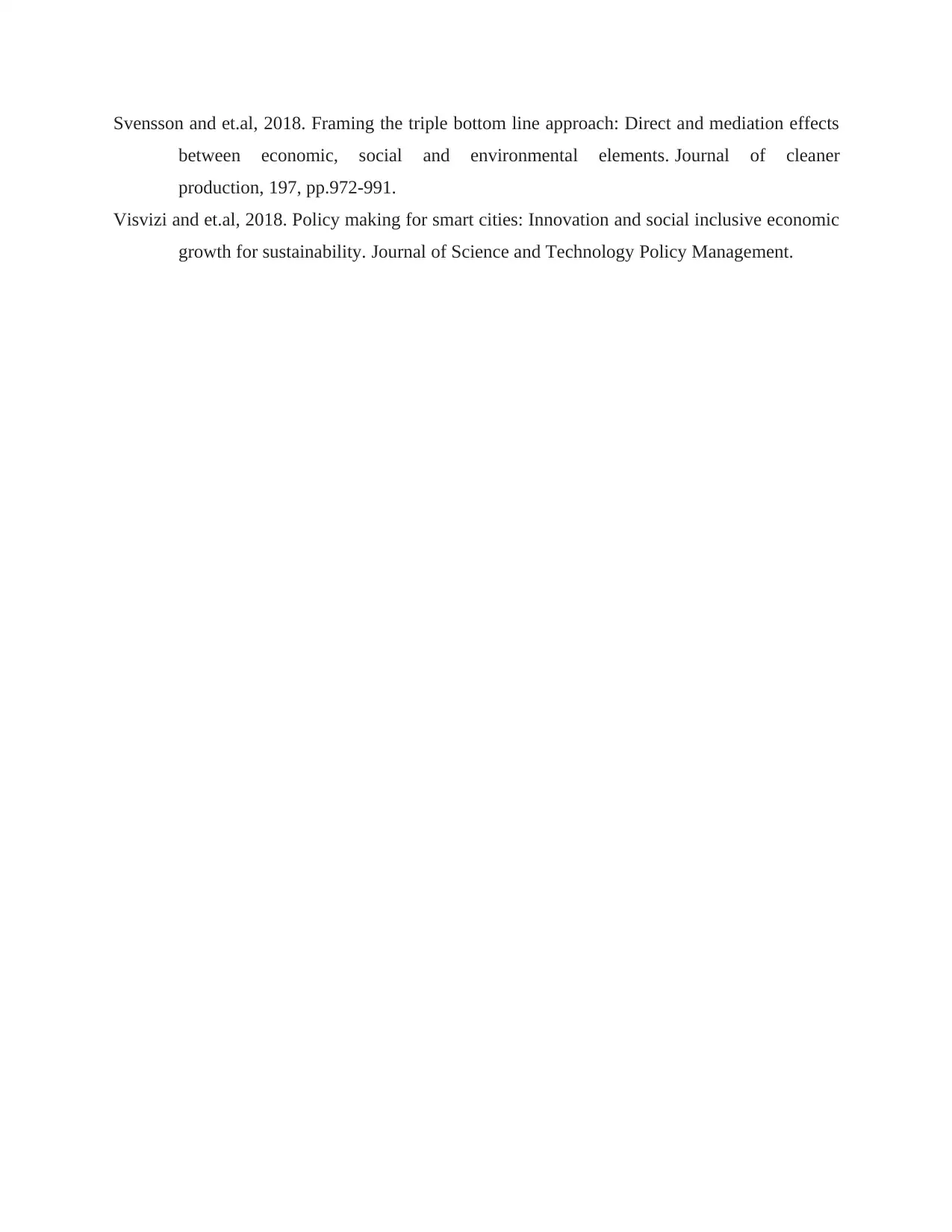
Svensson and et.al, 2018. Framing the triple bottom line approach: Direct and mediation effects
between economic, social and environmental elements. Journal of cleaner
production, 197, pp.972-991.
Visvizi and et.al, 2018. Policy making for smart cities: Innovation and social inclusive economic
growth for sustainability. Journal of Science and Technology Policy Management.
between economic, social and environmental elements. Journal of cleaner
production, 197, pp.972-991.
Visvizi and et.al, 2018. Policy making for smart cities: Innovation and social inclusive economic
growth for sustainability. Journal of Science and Technology Policy Management.
1 out of 10
Related Documents
Your All-in-One AI-Powered Toolkit for Academic Success.
+13062052269
info@desklib.com
Available 24*7 on WhatsApp / Email
![[object Object]](/_next/static/media/star-bottom.7253800d.svg)
Unlock your academic potential
Copyright © 2020–2025 A2Z Services. All Rights Reserved. Developed and managed by ZUCOL.




